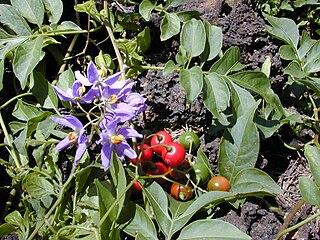
Solanum is a large and diverse genus of flowering plants, which include three food crops of high economic importance: the potato, the tomato and the eggplant. It is the largest genus in the nightshade family Solanaceae, comprising around 1,500 species. It also contains the so-called horse nettles, as well as numerous plants cultivated for their ornamental flowers and fruit.

Sambucus is a genus of flowering plants in the family Adoxaceae. The various species are commonly referred to as elder, elderflower or elderberry.

Pyracantha is a genus of large, thorny evergreen shrubs in the family Rosaceae, with common names firethorn or pyracantha. They are native to an area extending from Southwest Europe east to Southeast Asia. They resemble and are related to Cotoneaster, but have serrated leaf margins and numerous thorns.

Solanum dulcamara is a species of vine in the genus Solanum of the family Solanaceae. Common names include bittersweet, bittersweet nightshade, bitter nightshade, blue bindweed, Amara Dulcis, climbing nightshade, felonwort, fellenwort, felonwood, poisonberry, poisonflower, scarlet berry, snakeberry, trailing bittersweet, trailing nightshade, violet bloom, and woody nightshade.

Conium is a genus of flowering plants in the family Apiaceae. As of December 2020, Plants of the World Online accepts six species.

Daphne is a genus of between 70 and 95 species of deciduous and evergreen shrubs in the family Thymelaeaceae, native to Asia, Europe and north Africa. They are noted for their scented flowers and often brightly coloured berries. Two species are used to make paper. Many species are grown in gardens as ornamental plants; the smaller species are often used in rock gardens. All parts of daphnes are poisonous, especially the berries.

Philodendron is a large genus of flowering plants in the family Araceae. As of June 2013, the Plants of the World Online accepted 621 species; other sources accept different numbers. Regardless of number of species, the genus is the second-largest member of the family Araceae, after genus Anthurium. Taxonomically, the genus Philodendron is still poorly known, with many undescribed species. Many are grown as ornamental and indoor plants. The name derives from the Greek words philo- 'love, affection' and dendron 'tree'. The generic name, Philodendron, is often used as the English name.

Nerium oleander, commonly known as oleander or rosebay, is a shrub or small tree cultivated worldwide in temperate and subtropical areas as an ornamental and landscaping plant. It is the only species currently classified in the genus Nerium, belonging to subfamily Apocynoideae of the dogbane family Apocynaceae. It is so widely cultivated that no precise region of origin has been identified, though it is usually associated with the Mediterranean Basin.
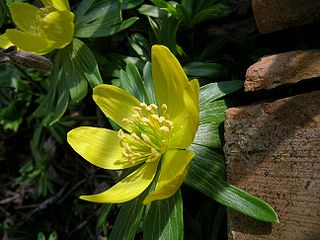
Eranthis hyemalis, the winter aconite, is a species of flowering plant in the buttercup family Ranunculaceae, native to calcareous woodland habitats in France, Italy and the Balkans, and widely naturalized elsewhere in Europe.

Toxicoscordion venenosum, with the common names death camas and meadow death camas, is a species of flowering plant in the family Melanthiaceae. It is named for its well known toxic qualities, with both its common names and its scientific name referencing this. Because its nectar is also poisonous, it is mainly pollinated by the death camas miner bee, which specializes in collecting the toxic pollen for its young. It is native to western North America from New Mexico to Saskatchewan and west to the Pacific Ocean.
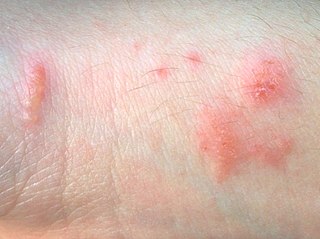
Urushiol-induced contact dermatitis is a type of allergic contact dermatitis caused by the oil urushiol found in various plants, most notably sumac family species of the genus Toxicodendron: poison ivy, poison oak, poison sumac, and the Chinese lacquer tree. The name is derived from the Japanese word for the sap of the Chinese lacquer tree, urushi. Other plants in the sumac family also contain urushiol, as do unrelated plants such as Ginkgo biloba.
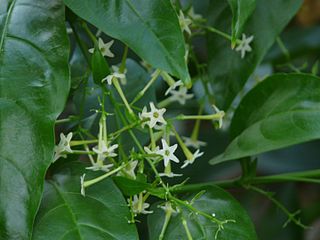
Cestrum nocturnum, the lady of the night, night-blooming jasmine, night-blooming jessamine, night-scented jessamine, night-scented cestrum or poisonberry, is a species of plant in the potato family Solanaceae. It is native to the West Indies, but naturalized in South Asia.
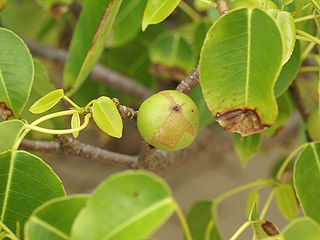
The manchineel tree is a species of flowering plant in the spurge family (Euphorbiaceae). Its native range stretches from tropical southern North America to northern South America.

Nertera granadensis, also known as coral bead plant, pin-cushion plant, coral moss, or English baby tears, is a plant with orange berries, of the genus Nertera. Nertera granadensis with an unusually extensive transcontinental distribution surrounding the Pacific Ocean, occurring from southern Chile and western Argentina north to Guatemala, and in Hawaii, New Zealand, eastern Australia, Indonesia, Malaysia, Papua New Guinea, the Philippines and Taiwan, possibly due to its cultivation as ground-cover. In tropical biomes of the western Pacific, Nertera granadensis only occurs at high altitudes. It does also occur on the Juan Fernández Islands. It is grown as an ornamental plant in gardens, and the name given to the plant in Mapudungun and Chilean Spanish is rucachucao. The name granadensis derives from New Granada, the old name of Colombia.

Actaea rubra, the red baneberry or chinaberry, is a poisonous herbaceous flowering plant in the family Ranunculaceae, native to North America.

Aconitum napellus, monkshood, aconite, Venus' chariot or wolfsbane, is a species of highly toxic flowering plants in the genus Aconitum of the family Ranunculaceae, native and endemic to western and central Europe. It is an herbaceous perennial plant growing to 1 m tall, with hairless stems and leaves. The leaves are rounded, 5–10 cm (2.0–3.9 in) diameter, palmately divided into five to seven deeply lobed segments. The flowers are dark purple to bluish-purple, narrow oblong helmet-shaped, 1–2 cm (0.39–0.79 in) tall. Plants native to Asia and North America formerly listed as A. napellus are now regarded as separate species. The plant is extremely poisonous in both ingestion and body contact. It is the most poisonous plant in all of Europe.

Daphne laureola, commonly called spurge-laurel, is a shrub in the flowering plant family Thymelaeaceae. Despite the name, this woodland plant is neither a spurge nor a laurel. Its native range covers much of Europe and extends to Algeria, Morocco and the Azores.
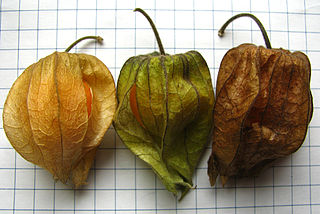
Physalis heterophylla, colloquial name clammy groundcherry, is species of herbaceous plant in the family Solanaceae. It is native to North America, occurring primarily in the eastern United States and Canada. It is known to occur in all contiguous states except for Nevada and California. It is found mainly in habitats such as dry or mesic prairies, gravel hills and rises, sandy or rocky soils, and waste places such as roadsides.

Daphnin is a plant toxin with the chemical formula C15H16O9 and is one of the active compounds present in the Eurasian and North African genus Daphne of the Thymelaeaceae, a plant family with a predominantly Southern Hemisphere distribution with concentrations in Australia and tropical Africa.
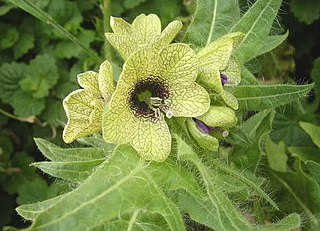
Hyoscyameae is an Old World tribe of the subfamily Solanoideae of the flowering plant family Solanaceae. It comprises seven genera: Anisodus, Atropa, Atropanthe, Hyoscyamus, Physochlaina, Przewalskia and Scopolia. The genera Atropanthe and Przewalskia are monotypic, the first being endemic to China and the second to Tibet.

























